
SLC 5/01™ and SLC 5/02™ Modular
Processors
(Catalog Numbers 1747-L511, 1747-L514,
1747-L524)
Installation Instructions
English Section . . . . . . . . . . . . . . . . 3
Section en francais . . . . . . . . . . . . . 15
Deutscher Abschnitt . . . . . . . . . . . . 27
Sezione italiana . . . . . . . . . . . . . . . 39
Sección en español . . . . . . . . . . . . 51
Inside...
page
Allen-Bradley Replacements

SLC 5/01™ and SLC 5/02™ Modular
Processors
(Catalog Numbers 1747-L511, 1747-L514,
1747-L524)
Installation Instructions
English Section
Important User Information . . . . . . . . .4
For More Information . . . . . . . . . . . . 5
Required Tools and Equipment . . . . 6
Safety Considerations . . . . . . . . . . . 6
Installation Procedure . . . . . . . . . . . 7
Troubleshooting . . . . . . . . . . . . . . . . 9
Specifications . . . . . . . . . . . . . . . . . 10
Battery Handling, Storing, and
Transporting (Cat. No. 1747-BA) . . 12
Inside...
page

4
Publication 1747-5.25
Important User Information
Because of the variety of uses for the products described in this publication, those
responsible for the application and use of this control equipment must satisfy
themselves that all necessary steps have been taken to assure that each
application and use meets all performance and safety requirements, including any
applicable laws, regulations, codes and standards.
The illustrations, charts, sample programs and layout examples shown in this
guide are intended solely for purposes of example. Since there are many
variables and requirements associated with any particular installation,
Allen-Bradley does not assume responsibility or liability (to include intellectual
property liability) for actual use based upon the examples shown in this
publication.
Allen-Bradley publication SGI-1.1, Safety Guidelines for the Application,
Installation, and Maintenance of Solid-State Control (available from your local
Allen-Bradley office), describes some important differences between solid-state
equipment and electromechanical devices that should be taken into consideration
when applying products such as those described in this publication.
Reproduction of the contents of this copyrighted publication, in whole or in part,
without written permission of Allen-Bradley Company, Inc., is prohibited.
Throughout these installation instructions we use notes to make you aware of
safety considerations:
Attention statements help you to:
• identify a hazard
• avoid the hazard
• recognize the consequences
ATTENTION: Identifies information about practices or
circumstances that can lead to personal injury or death, property
damage or economic loss
Important:
Identifies information that is critical for successful application and
understanding of the product.
Allen-Bradley Replacements

5
Publication 1747-5.25
For More Information
As part of our effort to preserve, protect, and improve our environment,
Allen-Bradley is reducing the amount of paper we use. Less paper means more
options for you. In addition to traditional printed publications and CD-ROM
versions, we now offer on-line manuals with the most up-to-date information you
can get. We recommend that you read the related publications listed below
before starting up your control system.
Related Publications
If you would like a manual, you can:
• download a free electronic version from the internet:
www.theautomationbookstore.com
• purchase a printed manual by:
— contacting your local distributor or Rockwell Automation
representative
— visiting www.theautomationbookstore.com and placing your order
— calling 1.800.963.9548 (USA/Canada) or
001.330.725.1574 (Outside USA/Canada)
For Refer to this Document Pub. No.
A more detailed description on how to
install and use your modular SLC 500
system.
SLC 500 Modular
Hardware Style Installation
and Operation Manual
1747-6.2
A reference manual that contains status
file data, instruction set, and
troubleshooting information.
SLC 500 and MicroLogix
1000 Instruction Set
Reference Manual
1747-6.15
A CD–ROM containing both of the
manuals listed above, plus the:
•SLC 500 Analog I/O Modules User
Manual
•Discrete I/O Modules Installation
Instructions
•Discrete I/O Modules Product Data
SLC 500 Literature
Collection on CD–ROM
1747-CD1-1

6
Publication 1747-5.25
Required Tools and Equipment
• medium blade screwdriver
• programming equipment
• a 1747-PIC, 1784-KTX, or 1784-PCMK communication interfaces
Safety Considerations
For general recommendations concerning installation safety requirements and
safety related work practices, refer to the requirements specific to your region.
• Europe: Reference the standards found in EN 60204 and your national
regulations.
• United States: refer to NFPA 70E, Electrical Safety Requirements for
Employee Workplaces.
ATTENTION: Never install, remove, or wire any module while
power is applied. Also, do not expose processor modules to
surfaces or other areas that may typically hold an electrostatic
charge. Electrostatic charges can alter or destroy memory.
Important:
See page 10 for information on proper battery handling, storage, and
transporting.
Allen-Bradley Replacements

7
Publication 1747-5.25
Installation Procedure
Install the Battery
1. Open the door of the processor.
2. Remove the jumper from the battery connector socket. Store the jumper in
a safe place for possible future use without the battery.
3. Insert a new or replacement battery in the holder making sure it is held in by
the retainer clips.
4. Plug the battery connector into the socket. See the figure below.
5. Close the processor door.
Important:
If your processor has a battery— the battery is an option for the SLC
5/01 (1747-L511) processor — make sure it is connected before
installing your processor into the chassis. This provides memory
backup for your processor should the controller power supply fail.
Important:
See page 10 for information on proper battery handling, storage, and
transporting.
+
White
Lead
Red
Lead
Battery
Connector
Retainer
Clips

8
Publication 1747-5.25
Install the Processor
Make sure system power is off; then insert the processor into slot 0 of the 1746
chassis.
Apply Power to the Processor
1. Energize the chassis power supply.
2. Check the chassis power supply and processor LEDs. The power LED on the
power supply should be on and the fault LED on the processor should be
flashing.
Important:
The SLC 500t Modular Processors must be inserted into the left slot
(slot 0), as shown below. In addition, remove the protective wrap after
installing the processor.
Processor
Release
Card Guide
Protective Wrap
Power
Supply
Indicates the LED is OFF.
Indicates the LED is ON.
Indicates the LED is
FLASHING.
Status of LED does not matter.
POWER
RUN
CPU FAULT
FORCED I/O
BATTERY LOW
COMM
The RUN LED on the SLC 5/01
processor is actully labeled “PC
RUN.” Also, the SLC 5/01 processor
does not have a COMM LED.
Allen-Bradley Replacements

9
Publication 1747-5.25
Load Your Software
Refer to your programming software documentation.
Establish Communications with the Processor
1. Connect the 1747-PIC to the processor and your personal computer.
2. Set the communication parameters of the software to match the default
parameters of the processor:
— DH-485
— 19.2k baud
— Node Address = 1
Troubleshooting
Before troubleshooting your SLC 500 system, please obtain an SLC 500 Modular
Hardware Style Installation and Operation Manual (1747-6.2) from one of the
sources listed on page 3. Refer to the chapter on Troubleshooting.
In addition to the SLC 500 Modular Hardware Style Installation and Operation
Manual, the SLC 500 and MicroLogix 1000 Instruction Set Reference Manual
(1747-6.15) may also be obtained from the sources listed on page 3. This manual
contains explanations and examples for the entire instruction set as well as for all
status words and bits. It also contains explanations for all possible fault codes
found in status word S:6.

10
Publication 1747-5.25
Specifications
Specification
SLC 5/01
(1747-L511, -L514)
SLC 5/02
(1747-L524)
Program Memory 1K or 4K Instructions 4K Instructions
Additional Data Storage 0 0
Maximum I/O Capacity
3940 discrete inputs
3940 discrete outputs
4096 discrete inputs
4096 discrete outputs
Max. Local Chassis/Slots 3/30 3/30
Programming Software RSLogix 500™ , PLC–500 A.I. Series™, APS, and HHT
Programming Instructions 52 71
Typical Scan Time
(1)
(1)
The scan times are typical for a 1K ladder logic program consisting of simple ladder logic and
communication servicing. Actual scan times depend on your program size, instuctions used, and
the communication protocol.
8 ms/K 4.8 ms/K
Bit Execution (XIC) 4 µs 2.4 µs
Communication Receive Receive or Initiate
DH-485 SLC 5/01
(1)
(1)
A 1747-PIC is required when connecting to the DH-485 channel for programming.
SLC 5/02
(1)
Allen-Bradley Replacements

11
Publication 1747-5.25
The following table summarizes the available memory back up options for the
SLC 5/01 and SLC 5/02 processors. EEPROM and UVPROM memory modules
provide non-volatile memory back-up.
Description Specification
Power Supply Loading at 5V dc 350 mA
Power Supply Loading at 24V dc 105 mA
Program Scan Hold-up Time after Loss of
Power
20 ms to 3 s (dependent on power supply loading)
Noise Immunity NEMA Standard ICS 2-230
Vibration
Displacement: 0.015 inch, peak-to-peak at 5-57
Hz
Acceleration: 2.5Gs at 57-2000 Hz
Shock (operating) 30Gs
Ambient Temperature Rating
Operating: 0 to + 60
°
C (32
°
F to 140
°
F)
Storage: 40
°
C to 85
°
C (-40
°
F to 185
°
F)
Humidity 5 to 95% without condensation
Agency Certification
UL listed
CSA approved
Class 1, Groups A, B, C or D, Division 2
CE compliant for all applicable directives
Memory Back Up Option
SLC 5/01
(1747-L511/1747-L514)
SLC 5/02
(1747-L524)
EEPROM 1747-M1, 1747-M2 1747-M2
UVPROM 1747-M3, 1747-M4 1747-M4

12
Publication 1747-5.25
Battery Handling, Storing, and Transporting (Cat. No. 1747-BA)
Handling
Storing
Store the lithium batteries in a cool, dry environment, typically +20° C to +25° C
(+68° F to +77° F) and 40% to 60% relative humidity.
Transporting
One or Two Batteries — Up to two batteries can be shipped together within the
United States without restriction. Regulations governing shipment to or within
other countries may differ.
Three or More Batteries — Procedures for the transportation of three or more
batteries shipped together within the United States are specified by the
Department of Transportation (DOT) in the Code of Federal Regulations,
CFR49, “Transportation.” An exemption to these regulations, DOT - E7052,
covers the transport of certain hazardous materials classified as flammable solids.
This exemption authorizes transport of lithium batteries by motor vehicle, rail
freight, cargo vessel, and cargo-only aircraft, providing certain conditions are
met. Transport by passenger aircraft is not permitted.
Shipment of depleted batteries for disposal may be subject to specific regulation
of the countries involved or to regulations endorsed by those countries, such as
the IATA Restricted Articles Regulations of the International Air Transport
Association, Geneva, Switzerland.
ATTENTION: Do not charge the batteries. An explosion could
result or the cells could overheat causing burns.
Do not open, puncture, crush, or otherwise mutilate the batteries.
An explosion may result and/or toxic, corrosive, and flammable
liquids would be exposed.
Important:
Regulations for transportation of lithium batteries are periodically
revised.
Allen-Bradley Replacements

13
Publication 1747-5.25
For disposal, batteries must be packaged and shipped in accordance with
transportation regulations, to a proper disposal site. The U.S. Department of
Transportation authorizes shipment of “Lithium batteries for disposal” by motor
vehicle only in regulation 173.1015 of CFR 49 (effective January 5, 1983). For
additional information contact:
U.S. Department of Transportation
Research and Special Programs Administration
400 Seventh Street, S.W.
Washington, D.C. 20590
Although the Environmental Protection Agency at this time has no regulations
specific to lithium batteries, the material contained may be considered toxic,
reactive, or corrosive. The person disposing of the material is responsible for any
hazard created in doing so. State and local regulations may exist regarding the
disposal of these materials.
For a lithium battery material safety data sheet, contact the manufacturer:
Sanyo Energy Corporation
600 Supreme Drive
Bensenville, IL 60106
ATTENTION: Do not incinerate or dispose of lithium batteries in
general trash collection. Explosion or violent rupture is possible.
Batteries should be collected for disposal in a manner to prevent
against short circuiting, compacting, or destruction of case integrity
and hermetic seal.

Processeurs modulaires SLC 5/01™
et SLC 5/02™
(Références 1747-L511, 1747-L514, 1747-L524)
Notice d’installation
Section en francais
Informations utilisateur ............................ 16
Complément d’informations .................... 17
Outils et équipement requis .................... 18
Considérations de sécurité ...................... 18
Procédure d’installation ........................... 19
Dépannage .............................................. 21
Spécifications .......................................... 22
Manipulation, stockage et transport de piles
(Réf. 1747-BA) ........................................ 24
pageContenu...
Allen-Bradley Replacements

16
Publication 1747-5.25
Informations utilisateur
En raison de la diversité des utilisations des produits décrits dans le présent
manuel, les personnes responsables de l’équipement doivent s’assurer que toutes
les mesures ont été prises pour que l’application et l’utilisation des produits
soient conformes aux exigences de performance et de sécurité, ainsi qu’aux lois,
règlements, codes et normes en vigueur.
Les illustrations, schémas et exemples de programmes contenus dans ce manuel
sont présentés à titre indicatif seulement. En raison des nombreuses variables et
impératifs associés à chaque installation, la société Allen-Bradley ne saurait être
tenue pour responsable ou redevable (y compris en matière de propriété
intellectuelle) des suites d’utilisation réelle basée sur les exemples et schémas
présentés dans ce manuel.
La publication SGI-1.1, Safety Guidelines for the Application, Installation, and
Maintenance of Solid-State Control (disponible auprès de votre agence
commerciale Allen-Bradley) décrit certaines différences importantes entre les
équipements électroniques et les équipements électromécaniques qui devront être
prises en considération lors de l’application de ces produits comme indiqué dans
la présente publication.
Toute reproduction partielle ou totale du présent manuel sans autorisation écrite
de la société Allen-Bradley est interdite.
Des remarques sont utilisées tout au long de ce manuel pour attirer votre attention
sur les mesures de sécurité à prendre en compte :
Les encarts Attention vous aident à :
• identifier un danger
• éviter un danger
• discerner les conséquences
ATTENTION:
Indique les informations sur les pratiques ou
circonstances pouvant entraîner des dommages corporels, dégâts
matériels ou pertes financières.
Important:
Indique les informations déterminantes pour la bonne
compréhension et application du produit.

17
Publication 1747-5.25
Complément d’informations
Dans le cadre des efforts de protection, de sauvegarde et d’amélioration de
l’environnement, Allen-Bradley réduit la quantité de papier utilisé. Moins de
papier, c’est aussi un plus grand choix pour les utilisateurs : outre les publications
imprimées traditionnelles et versions sur CD-ROM, nous vous offrons
maintenant des manuels en ligne comportant les informations les plus récentes.
Nous vous recommandons de lire les publications associées, énumérées
ci-dessous, avant de lancer votre système de commande.
Publications associées
Comment obtenir plus d’informations
Pour vous procurer un manuel, vous pouvez :
• le charger gratuitement depuis le site Internet :
www.theautomationbookstore.com
• acheter un manuel imprimé. Pour cela :
— contactez votre distributeur local Rockwell Automation
— visitez www.theautomationbookstore.com et commandez-le en
ligne
— appelez le 1.800.963.9548 (USA/Canada)
ou le 001.330.725.1574 (hors USA/Canada)
Pour Voir ce document Réf.
Une description plus détaillée de l’installation et
de l’utilisation de votre système modulaire SLC
500.
SLC 500 Modular
Hardware Style
Installation and Operation
Manual
1747-6.2
Un manuel de référence comportant des
informations sur les données du fichier d’état, le
jeu d’instructions et le dépannage.
Manuel de référence et de
jeu d’instructions SLC 500
et MicroLogix 1000
1747-6.15FR
Un CD-ROM contenant les manuels énumérés
ci-dessus plus :
•Manuel d’utilisation des modules d’E/S
analogiques SLC 500
•Notice d’installation des modules d’E/S TOR
•Description produit des modules d’E/S TOR
Ensemble des manuels
SLC 500 sur CD-ROM
1747-CD1-1
Allen-Bradley Replacements

18
Publication 1747-5.25
Outils et équipement requis
• un tournevis plat de taille moyenne
• un équipement de programmation
• une interface de communication 1747-PIC, 1784-KTX ou 1784-PCMK
Considérations de sécurité
Pour connaître les recommandations générales relatives aux impératifs de
sécurité d’installation et de protection des postes de travail, reportez-vous aux
normes en vigueur dans votre région.
• Europe : Référence aux normes EN 60204 et aux réglementations
nationales.
• Etats–Unis : Référence au NFPA 70E, « Electrical Safety Requirements for
Employee Workplaces ».
ATTENTION: Ne jamais installer, retirer ou câbler un module
sous tension. N’exposez pas les modules processeurs aux surfaces
ou autres zones généralement soumises à des charges
électrostatiques. Les charges électrostatiques peuvent endommager
ou détruire la mémoire.
Important:
Pour plus d’informations sur la manipulation, le stockage et le
transport des piles, reportez-vous à la page 23.

19
Publication 1747-5.25
Procédure d’installation
Installation de la pile
1. Ouvrez la porte du processeur.
2. Retirez le cavalier de la fiche du connecteur de la pile. Conservez le cavalier
dans un endroit sûr afin de pouvoir l’utiliser ultérieurement sans la pile.
3. Insérez une nouvelle pile ou une pile de rechange dans le support en veillant
à ce qu’elle soit retenue par les clips de blocage.
4. Branchez le connecteur de la pile dans la fiche. Voir figure ci-dessous.
5. Refermez la porte du processeur.
Important:
Si votre processeur est équipé d’une pile — la pile est une option du
processeur SLC 5/01 (1747-L511) — assurez-vous qu’elle est
connectée avant d’installer le processeur dans le châssis. La pile
assure la sauvegarde de la mémoire en cas de coupure de courant de
votre processeur.
Important:
Pour plus d’informations sur la manipulation, le stockage et le
transport des piles, reportez-vous à la page 23.
+
Fil
blanc
Fil
rouge
Connecteur
de la pile
Clips de
blocage
Allen-Bradley Replacements

20
Publication 1747-5.25
Installation du processeur
Assurez-vous que l’alimentation est hors tension, puis insérez le processeur dans
l’emplacement 0 du châssis 1746.
Mise sous tension du processeur
1. Mettez l’alimentation du châssis sous tension.
2. Surveillez les LED de l’alimentation et du processeur. La LED « POWER »
de l’alimentation doit être allumée et la LED d’erreur du processeur doit
clignoter.
Important:
Les processeurs modulaires SLC 500t doivent être insérés dans
l’emplacement de gauche (emplacement 0), comme illustré
ci-dessous. Retirez la bande de protection après avoir installé le
processeur.
Alimentation
Guide-carte
Bande de protection
Loquet du
processor
Indique que la LED est éteinte.
Indique que la LED est allumée.
Indique que la LED clignote.
L’etat de la LED n’a pas d’importanc
e
POWER
RUN
CPU FAULT
FORCED I/O
BATTERY LOW
COMM
La LED RUN du processeur SLC 5/01 est
appelée PC RUN. Le processeur SLC 5/
01 n’a pas de LED COMM.

21
Publication 1747-5.25
Chargement de votre logiciel
Réferez-vous à la documentation de votre logiciel de programmation.
Establissement des communications avec le processeur
1. Connectez le 1747-PIC au processeur et à votre ordinateur personnel.
2. Définissez les paramètres de communication du logiciel en fonction des
paramètres par défaut du processeur :
• DH-485
• 19,2 kbauds
• Adresse de poste = 1
Dépannage
Avant de commencer à dépanner votre système SLC 500, veuillez vous procurer
le Manuel d’installation et de fonctionnement des SLC 500 modulaires
(1747-6.2) auprès d’une des sources de documentation présentées en page 16.
Référez-vous au chapitre relatif au dépannage.
Outre le manuel précité, le Manuel de référence et jeu d’instructions du SLC 500
et du MicroLogix 1000 (1747-6.15FR) peut également être obtenu auprès des
sources de documentation présentées en page 16. Ce manuel comporte des
explications et exemples pour l’ensemble du jeu d’instructions ainsi que pour
tous les mots et bits d’états. Il comporte également les explications de tous les
codes d’erreur possibles contenus dans le mot d’état S:6.
Allen-Bradley Replacements

22
Publication 1747-5.25
Spécifications
Spécification
SLC 5/01
(1747-L511, -L514)
SLC 5/02
(1747-L524)
Mémoire programme 1 K ou 4 K instructions 4 K instructions
Stockage de données
sup.
00
Capacité d’E/S maximum
3940 entrées TOR
3940 sorties TOR
4096 entrées TOR
4096 sorties TOR
Nbre maxi de châssis
locaux/emplacements
3/30 3/30
Logiciel de
programmation
RSLogix 500
t
, PLC-500 A.I. Series
t
, APS et HHT
Instructions de
programmation
52 71
Durée de scrutation
type
(1)
(1)
Les durées de scrutation sont généralement calculées pour un programme de logique à relais 1 K
composé d’une logique à relais simple et du traitement des communications. Les durées de
scrutations réelles dépendent de la taille de votre programme, des instructions utilisées et du
protocole de communication.
8 ms/K 4,8 ms/K
Exécution de bit (XIC) 4
µ
s2,4
µ
s
Communication Réception Réception ou envoi
DH-485 SLC 5/01
(1)
(1)
Un 1747-PIC est nécessaire pour la connexion de la voie DH-485 à des fins de
programmation.
SLC 5/02
(1)
Seite wird geladen ...
Seite wird geladen ...
Seite wird geladen ...
Seite wird geladen ...
Seite wird geladen ...
Seite wird geladen ...
Seite wird geladen ...
Seite wird geladen ...
Seite wird geladen ...
Seite wird geladen ...
Seite wird geladen ...
Seite wird geladen ...
Seite wird geladen ...
Seite wird geladen ...
Seite wird geladen ...
Seite wird geladen ...
Seite wird geladen ...
Seite wird geladen ...
Seite wird geladen ...
Seite wird geladen ...
Seite wird geladen ...
Seite wird geladen ...
Seite wird geladen ...
Seite wird geladen ...
Seite wird geladen ...
Seite wird geladen ...
Seite wird geladen ...
Seite wird geladen ...
Seite wird geladen ...
Seite wird geladen ...
Seite wird geladen ...
Seite wird geladen ...
Seite wird geladen ...
Seite wird geladen ...
Seite wird geladen ...
Seite wird geladen ...
Seite wird geladen ...
Seite wird geladen ...
Seite wird geladen ...
Seite wird geladen ...
-
 1
1
-
 2
2
-
 3
3
-
 4
4
-
 5
5
-
 6
6
-
 7
7
-
 8
8
-
 9
9
-
 10
10
-
 11
11
-
 12
12
-
 13
13
-
 14
14
-
 15
15
-
 16
16
-
 17
17
-
 18
18
-
 19
19
-
 20
20
-
 21
21
-
 22
22
-
 23
23
-
 24
24
-
 25
25
-
 26
26
-
 27
27
-
 28
28
-
 29
29
-
 30
30
-
 31
31
-
 32
32
-
 33
33
-
 34
34
-
 35
35
-
 36
36
-
 37
37
-
 38
38
-
 39
39
-
 40
40
-
 41
41
-
 42
42
-
 43
43
-
 44
44
-
 45
45
-
 46
46
-
 47
47
-
 48
48
-
 49
49
-
 50
50
-
 51
51
-
 52
52
-
 53
53
-
 54
54
-
 55
55
-
 56
56
-
 57
57
-
 58
58
-
 59
59
-
 60
60
Allen-Bradley SLC 5/01 Installation Instructions Manual
- Typ
- Installation Instructions Manual
- Dieses Handbuch eignet sich auch für
in anderen Sprachen
- English: Allen-Bradley SLC 5/01
- français: Allen-Bradley SLC 5/01
- español: Allen-Bradley SLC 5/01
- italiano: Allen-Bradley SLC 5/01
Verwandte Artikel
-
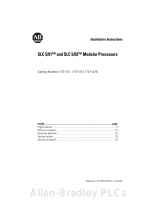 Allen-Bradley SLC 5/01 Installation Instructions Manual
Allen-Bradley SLC 5/01 Installation Instructions Manual
-
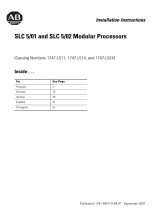 Allen-Bradley 1747-L524 Installationsanleitung
Allen-Bradley 1747-L524 Installationsanleitung
-
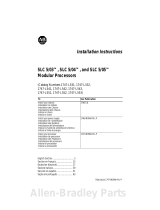 Allen-Bradley SLC 5/05 Installation Instructions Manual
Allen-Bradley SLC 5/05 Installation Instructions Manual
-
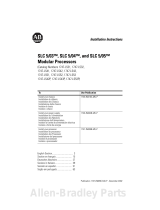 Allen-Bradley SLC 5/05 Installation Instructions Manual
Allen-Bradley SLC 5/05 Installation Instructions Manual
-
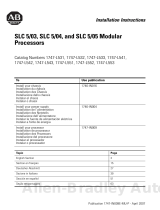 Allen-Bradley SLC 5/05 Installation Instructions Manual
Allen-Bradley SLC 5/05 Installation Instructions Manual
-
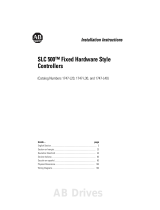 Allen-Bradley SLC 500 1747-L30 Installation Instructions Manual
Allen-Bradley SLC 500 1747-L30 Installation Instructions Manual
-
Rockwell Automation SLC 500 Installationsanleitung
-
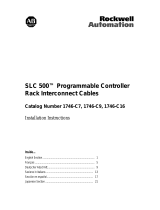 Allen-Bradley SLC 500 Series Installation Instructions Manual
Allen-Bradley SLC 500 Series Installation Instructions Manual
-
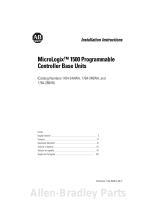 Allen-Bradley micrologix 1500 Installation Instructions Manual
Allen-Bradley micrologix 1500 Installation Instructions Manual
-
 Rockwell Automation Allen-Bradley MicroLogix 1500 1764-28BXB Installation Instructions Manual
Rockwell Automation Allen-Bradley MicroLogix 1500 1764-28BXB Installation Instructions Manual




































































